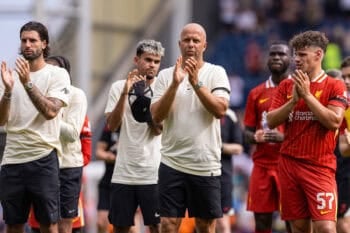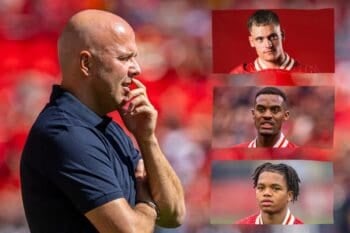Marco Lopes provides an update on Liverpool’s revenues from the 2011/12 season, as reported by the Deloitte Money League report for 2013, and provides analysis and insights on incoming revenues compared to past years, and other European clubs. This is the first article of a 3-part series.

FOOTBALL is a business – and much of a club’s success relies on its ability to bring in revenues effectively and apply spending in a clever way to yield results. Many of us may not like how money has become a heartstring beating at the core of our favourite sport, but to ignore its effect and important is ignorance a modern football fan cannot afford.
While the prudent debates rage on about being patient with Liverpool, the Rodgers regime, the gradual improvements in performances and results, and the promise of potential, there is an equally intriguing challenge occurring off the pitch. Not long ago, one of my earlier pieces on This Is Anfield provided some thoughts on Liverpool’s revenues as reported and assessed at the end of the 2010/11 season. With the new edition of the Deloitte Money League’s report for 2013 having been recently published, some new insights emerge from the report for Liverpool’s place in the English and European football finance hierarchy.
Clubs have 3 core sources of revenue – matchday (good old bums on seats, largely driven by stadium numbers), broadcasting (money from TV coverage – and typically, the more matches, and the more significant, the more money), and lastly commercial (everything from shirt sales to sponsorship deals). While revenues only provide half the picture, they do tell a story, and the story for Liverpool is one of promise, prudence… and significant challenges ahead.
A proviso on the following analysis – I’m no finance expert; I’m merely an interested Liverpool fan with ideas on what the numbers could implicate. I highly recommend reading the latest Deloitte Money League report yourself should you crave more insight into football’s financial wilderness.
Making up for lost European football

(Note – Analysis has been done for the last 8 years as a reasonable sample for analysis, given financial reports available, as well as to allow for proper analysis between Liverpool, Man Utd, Arsenal and the title winning era of Chelsea, which commenced in 2004, and the recent emergence of Man City and Spurs.)
We kick off with a review of Liverpool’s finances specifically. While it sounds decent that Liverpool’s total revenues have increased by 54% in 8 years, the last 4 years have seen a 2,1% growth in total revenues earned. The cynical may immediately point to the new owners, but as with most things financial, context is needed. Under FSG, Liverpool have experienced incredible commercial revenues of £77 and £80 million in the last 2 seasons, both the highest they’ve ever been in 8 years. Again, we can be cynical and criticise a distinct strategy by the owners to milk the Liverpool brand for what it is worth – but ironically, as you’ll read later, this number could (and should) be even higher. The team’s matchday revenues reached £45 million in 2011/12, also an 8 year high.
What has been damaging to Liverpool’s recent fortunes is broadcasting revenues. If anyone wanted to get a small taste of what a higher league placing in the Premier League, and Champions League qualifications means in revenue terms (never mind reputation and attracting quality players), this tells the largest story. Even Rafa’s maligned final season (when Liverpool underachieved with a 7th placed finish in the league, exited the Champions League at the group stage and nearly made up for it as semifinalists in the Europa League) generated significantly higher broadcasting revenues than recent years. Simplistically, staying in Europe keeps a club receiving a share of UEFA TV revenue, even if they end up being eliminated early on. 2010/11 and 2011/12 have been devoid of Champions League riches – and the swing in finances hurts significantly.

When you consider Liverpool’s results in their various competitions in the past 8 years (see above infographic), it’s an unusual picture to analyse – after all, Liverpool’s best years in the Champions League didn’t necessarily grant the largest sums in broadcasting money in those specific years. But one needs to consider the effect of increased UEFA distributions from 2006/2007 (explained in Deloitte’s 2010 Money League report) onwards, and Liverpool’s relative inconsistency and lacking performances in the domestic cup competitions, which affect the share of TV revenue domestically. One would think Dalglish’s cup runs went some way to softening the blow of lacking European football and finishing 8th in the league – but it barely touched sides in terms of finances. I wasn’t able to track down exact numbers for 2011/12, but comparisons with previous years suggest that being FA Cup and League Cup finalists probably earned the club a tidy sum of between £4-£6 million. Compare that to Liverpool’s last forage into Champions League football, despite an early exit at the group stage, still earned them a healthy packet of €28 million, a very large portion of coming from “market pool” distributions, which simplistically relate to TV money earned by the club due to its track record both domestically and in Europe, not to mention the popularity of the English league.
FSG – Finding Stability and Growth?

In fact, what this all does highlight is some shrewdness on the part of FSG. The lack of Champions League money and the poorest league runs for a decade together have contributed to damage Liverpool’s revenues. FSG can’t fully control (but they can influence) on-pitch improvements (which affect broadcasting revenues), nor can they invest in 15k extra seats that build themselves in a week, so they’ve tried to rescue the shortfall of £15 million (or so) through the immediate measure they have – commercial negotiations. The increases in commercial revenue through the Warrior and Standard Charted deals reflect this perfectly.
For a club, like Liverpool, to still be in the top 10 earning clubs in the world as of season 2011/12, especially despite the lack of Champions League money for 2 years, says a lot about FSG’s prudence and strategy to do as much as they can in the short term. Maybe many of us wanted more active work on the stadium – and I’m not knocking the idea, it is still a very important component that MUST be addressed – but FSG haven’t wasted time in trying to get the revenue that could be available. The criticisms you can make of FSG are more likely to be that they could have done more, but that aspect becomes more difficult to judge.
FSG’s strategy to manage the wage bill may also have been frowned upon, but now that the Premier League has released its new financial rules and linked some of them to its highly lucrative £5.5 billion TV revenue pot, it is crucial for Liverpool to get the wage bill under control, and in line with the current and projected performances of the team. To be even more specific, the Guardian’s article quotes “… further increases to the wage bill are permissible in line with any uplift in a club’s commercial or match-day income – the curbs apply only to the central TV money distributed by the league. On the latest available figures, only seven clubs would be under the £52m cap.” This means the broadcasting revenues that English clubs earn would be the figures under threat, and by extension overall revenues through possible points deductions.
Liverpool are one of the 13 clubs OVER the wage cap. I’m unsure how the Premier League would enforce things, but logically the only reasons Liverpool could still get away with a higher wage bill is because their matchday, and commercial revenues (the latter in particular) justify the club’s investment in greater wages – to a point. FSG’s strategy of containment, and investment in future growth looks correct… for now. If FSG are trying to ensure that the club can invest and sustain a given level of spending for a top club regardless of its success on the pitch (which in itself is a controversial statement), they’ve started the right conversations.
That of course, only makes sense if the other clubs you’re competing with have similar struggles. Part 2 of this series will start to explore that exact question.

















Fan Comments